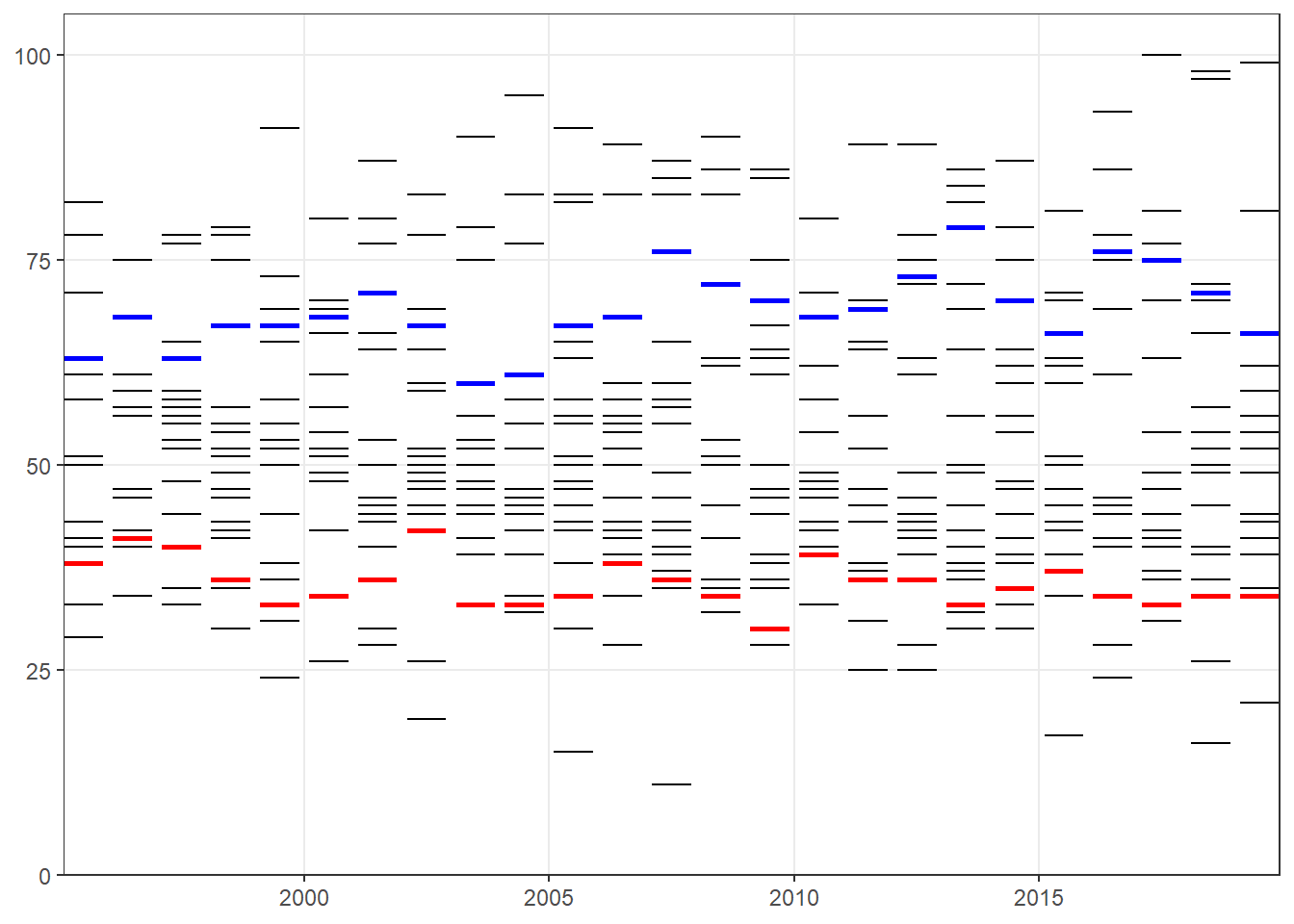library(tidyverse)We’ll be using Premier League results we’ve downloaded in the previous post:
df <- read_csv(
"EPL.csv",
col_types = "icccii"
)df %>%
head()
## # A tibble: 6 x 6
## Season Date HomeTeam AwayTeam FTHG FTAG
## <int> <chr> <chr> <chr> <int> <int>
## 1 1993 14/08/93 Arsenal Coventry 0 3
## 2 1993 14/08/93 Aston Villa QPR 4 1
## 3 1993 14/08/93 Chelsea Blackburn 1 2
## 4 1993 14/08/93 Liverpool Sheffield Weds 2 0
## 5 1993 14/08/93 Man City Leeds 1 1
## 6 1993 14/08/93 Newcastle Tottenham 0 1The first two seasons had 22 clubs competing, down to 20 from 1995 onwards:
df %>%
count(Season)
## # A tibble: 28 x 2
## Season n
## <int> <int>
## 1 1993 462
## 2 1994 462
## 3 1995 380
## 4 1996 380
## 5 1997 380
## 6 1998 380
## 7 1999 380
## 8 2000 380
## 9 2001 380
## 10 2002 380
## # ... with 18 more rowsFunction to generate league tables from match results:
league_table <- function(results) inner_join(
results %>%
group_by(
Team = HomeTeam
) %>%
summarise(
Pts = sum(FTHG > FTAG) * 3 + sum(FTHG == FTAG) * 1,
GF = sum(FTHG),
GA = sum(FTAG),
.groups = "drop"
) %>%
pivot_longer(
-Team
),
results %>%
group_by(
Team = AwayTeam
) %>%
summarise(
Pts = sum(FTHG < FTAG) * 3 + sum(FTHG == FTAG) * 1,
GF = sum(FTAG),
GA = sum(FTHG),
.groups = "drop"
) %>%
pivot_longer(
-Team
),
by = c(
"Team",
"name"
)
) %>%
transmute(
Team,
name,
value = value.x + value.y
) %>%
pivot_wider() %>%
arrange(
-Pts,
GA - GF,
-GF,
rev(Team)
) %>%
mutate(
Pos = row_number()
) %>%
select(
Pos,
everything()
)For example, the final standings for 2019/20:
df %>%
filter(
Season == 2019
) %>%
league_table() %>%
print.data.frame(
row.names = FALSE
)
## Pos Team Pts GF GA
## 1 Liverpool 99 85 33
## 2 Man City 81 102 35
## 3 Man United 66 66 36
## 4 Chelsea 66 69 54
## 5 Leicester 62 67 41
## 6 Tottenham 59 61 47
## 7 Wolves 59 51 40
## 8 Arsenal 56 56 48
## 9 Sheffield United 54 39 39
## 10 Burnley 54 43 50
## 11 Southampton 52 51 60
## 12 Everton 49 44 56
## 13 Newcastle 44 38 58
## 14 Crystal Palace 43 31 50
## 15 Brighton 41 39 54
## 16 West Ham 39 49 62
## 17 Aston Villa 35 41 67
## 18 Bournemouth 34 40 65
## 19 Watford 34 36 64
## 20 Norwich 21 26 75League tables for every season from 1995/96 through 2019/20:
df_lt <- df %>%
filter(
Season %in% 1995:2019
) %>%
group_by(
Season
) %>%
group_nest() %>%
mutate_at(
vars(data),
map,
league_table
) %>%
unnest(
cols = data
)Let’s plot points vs table position, highlighting 4th (Champions League) and 18th (relegation) positions:
ggplot(
mapping = aes(
x = Season + .1,
y = Pts,
xend = Season + .9,
yend = Pts
)
) +
geom_segment(
data = df_lt
) +
geom_segment(
data = filter(
df_lt,
Pos == 4
),
colour = "blue",
size = 1
) +
geom_segment(
data = filter(
df_lt,
Pos == 18
),
colour = "red",
size = 1
) +
labs(
x = NULL,
y = NULL
) +
scale_x_continuous(
expand = expansion()
) +
scale_y_continuous(
expand = expansion(
mult = c(0, .05)
),
limits = c(0, NA)
) +
theme_bw() +
theme(
panel.grid.minor = element_blank()
)
The range of points that were required to get into Top 4:
df_lt %>%
filter(
Pos == 4
) %>%
pull(
Pts
) %>%
range()
## [1] 60 79…to avoid relegation:
df_lt %>%
filter(
Pos == 18
) %>%
pull(
Pts
) %>%
range()
## [1] 30 42